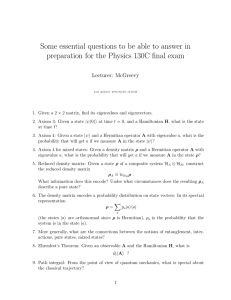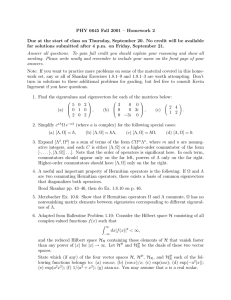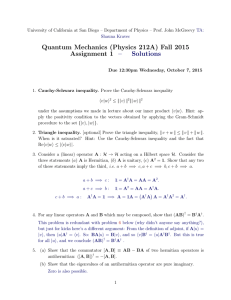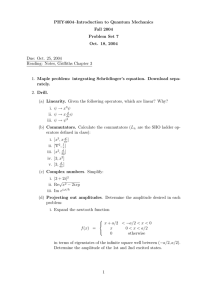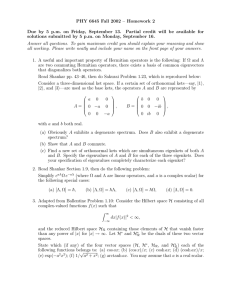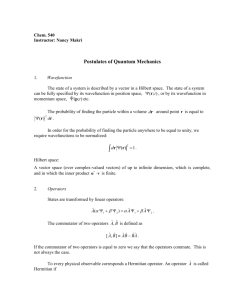Quantum Mechanics (Physics 212A) Fall 2015 Assignment 1 – Solutions
advertisement
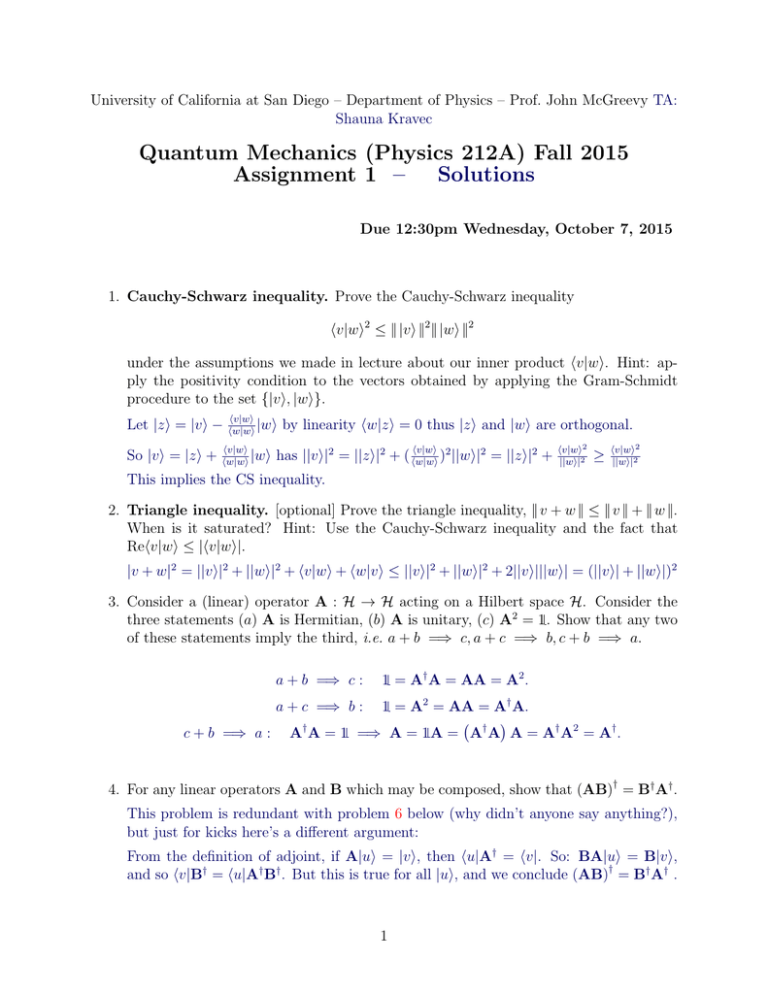
University of California at San Diego – Department of Physics – Prof. John McGreevy TA:
Shauna Kravec
Quantum Mechanics (Physics 212A) Fall 2015
Assignment 1 –
Solutions
Due 12:30pm Wednesday, October 7, 2015
1. Cauchy-Schwarz inequality. Prove the Cauchy-Schwarz inequality
hv|wi2 ≤ || |vi ||2 || |wi ||2
under the assumptions we made in lecture about our inner product hv|wi. Hint: apply the positivity condition to the vectors obtained by applying the Gram-Schmidt
procedure to the set {|vi, |wi}.
Let |zi = |vi −
So |vi = |zi +
hv|wi
|wi
hw|wi
hv|wi
|wi
hw|wi
by linearity hw|zi = 0 thus |zi and |wi are orthogonal.
hv|wi 2
has ||vi|2 = ||zi|2 + ( hw|wi
) ||wi|2 = ||zi|2 +
hv|wi2
||wi|2
≥
hv|wi2
||wi|2
This implies the CS inequality.
2. Triangle inequality. [optional] Prove the triangle inequality, || v + w || ≤ || v || + || w ||.
When is it saturated? Hint: Use the Cauchy-Schwarz inequality and the fact that
Rehv|wi ≤ |hv|wi|.
|v + w|2 = ||vi|2 + ||wi|2 + hv|wi + hw|vi ≤ ||vi|2 + ||wi|2 + 2||vi|||wi| = (||vi| + ||wi|)2
3. Consider a (linear) operator A : H → H acting on a Hilbert space H. Consider the
three statements (a) A is Hermitian, (b) A is unitary, (c) A2 = 1. Show that any two
of these statements imply the third, i.e. a + b =⇒ c, a + c =⇒ b, c + b =⇒ a.
a + b =⇒ c :
1 = A† A = AA = A2 .
1 = A2 = AA = A† A.
A† A = 1 =⇒ A = 1A = A† A A = A† A2 = A† .
a + c =⇒ b :
c + b =⇒ a :
4. For any linear operators A and B which may be composed, show that (AB)† = B† A† .
This problem is redundant with problem 6 below (why didn’t anyone say anything?),
but just for kicks here’s a different argument:
From the definition of adjoint, if A|ui = |vi, then hu|A† = hv|. So: BA|ui = B|vi,
and so hv|B† = hu|A† B† . But this is true for all |ui, and we conclude (AB)† = B† A† .
1
5. (a) Show that the commutator [A, B] ≡ AB − BA of two hermitian operators is
antihermitian: ([A, B])† = −[A, B].
([A, B])† = B † A† − A† B † = BA − AB = −[A, B]
(b) Show that the eigenvalues of an antihermitian operator are pure imaginary.
I claim an anti-hermitian operator A can be written as A = iB where B † = B
The spectrum of A is then necessarily the spectrum of B times i making it pure
imaginary. Zero is also possible.
6. Show that for any two linear maps which may be composed, T : V1 → V2 , S : V2 → V3 ,
(ST)† = T† S† .
Let {|ii}, {|ni}, {|ai} denote bases for V1,2,3 respectively. Then:
P
hi| (ST)† |ai = (ha|ST|ii)? = n (ha|S|nihn|T|ii)?
P
P
= n hn|S† |aihi|T† |ni = n hi|T† |nihn|S† |ai = hi|T† S† |ai.
7. For A and B hermitian operators, show that AB is hermitian if and only if A and B
commute.
From either 6 or 4, we know that in general,
(AB)† = B† A†
but for hermitian operators, the RHS is BA which is equal to the LHS only when
0 = AB − BA = [A, B].
8. Consider three normal operators A, B, C satisfying
[A, B] = 0, [A, C] = 0 but [B, C] 6= 0.
(a) Show that there must be a degeneracy in the spectrum of A.
Let {|bi} be a simultaneous eigenbasis of A and B guaranteed by the fact they
commute. Let {|ci} be the same for C.
P
P
A = b ab |bihb| = c ac |cihc| if these bases were the same then we would have
found a basis in which B and C are simultaneously diagonalizable.
This is impossible if [B, C] 6= 0. Therefore the set {|bi} is not the same as {|ci}
I claim the only place in which these sets can differ is on repeated eigenvalues.
Suppose a is a unique eigenvalue of A.
It is therefore associated with a single |bi and a single |ci. But the eigenspace is
one-dimensional by assumption of uniqueness. Therefore |bi and |ci are the same.
Therefore there must be degeneracy in the spectrum of A.
In that situation any linear combination of the degenerate eigenvectors is also an
eigenvector allowing for distinct orthonormal bases in this space.
2
(b) The nature of the degeneracy depends on the form of [B, C]. Suppose that [B, C]
is a nonzero c-number. Show that under this assumption the degeneracy of each
eigenvalue of A cannot be finite.
First it is worth noting that the algebra [B, C] = q1 has only infinite dimensional
representations. To see this consider a finite dimensional pair and take the trace
of BHS
Tr [B, C] = qTr 1 = q dimH but Tr [B, C] = Tr BC − Tr CB = 0 by cyclicity.
Therefore q = 0 or Tr 1 does not converge.
The proof of degeneracy of A being also infinite is similar but invokes the partial
trace.
Let Va be the eigenspace of A with some eigenvalue a. On Va , Tr Va [B, C] =
Tr Va q1 = qdim(Va )1
On the other hand, Tr Va [B, C] = Tr Va BC − Tr Va CB = 0
Note that the partial trace is not manifestly cyclic but because [A, B] = 0 = [A, C]
we can evaluate it in a simultaneous eigenbasis of B for example and get the
conclusion.
9. Supersymmetry algebra. Consider an operator Q satisfying Q2 = 0.
Let A ≡ QQ† + Q† Q.
Show that any nonzero eigenvalue of A is degenerate (that is, there is more than one
eigenvector with the same eigenvalue), but zero eigenvalues need not be.
Hint: consider the action of Q + Q† on an eigenstate of A.
A good example to keep in mind in doing this problem is a two state system with
0 1
+
x
y
Q ≡ σ ≡ σ + iσ =
, A = 1.
0 0
2
First notice that A = Q + Q† . Second notice that
AQ = QQ† Q = QA
i.e. [A, Q] = 0, A and Q commute. Similarly, A and Q† commute. Q and Q† are not
hermitian – in fact, since they square to zero, all their eigenvalues must
be zero (act
†
†
with Q on the eigenvalue equation for Q). But Q + Q and i Q − Q are hermitian
and simultaneously diagonalizable with A. Now suppose we have an A eigenstate:
A|αi = α|αi.
Consider the state Q|αi. Since [A, Q] = 0, it is also an A eigenstate with eigenvalue
α. Is it proportional to |αi, i.e. the same state? (If not, we have shown a degeracy.)
If it were,
Q|αi = q|αi
3
then it would be an eigenvector of Q with eigenvalue q. But we know that any eigenvalue of Q is zero. So the only case where there is not a degeneracy is when
Q|αi = 0 .
10. Normal matrices.
An operator (or matrix)  is normal if it satisfies the condition [Â, † ] = 0.
(a) Show that real symmetric, hermitian, real orthogonal and unitary operators are
normal.
Real symmetric is a special case of hermitian.
Let H be hermitian. [H, H † ] = [H, H] = 0
Real orthogonal is a special case of unitary.
Let U be unitary. [U, U † ] = U U † − U † U = 1 − 1 = 0
(b) Show that any operator can be written as  = Ĥ + iĜ where Ĥ, Ĝ are Hermitian.
[Hint: consider the combinations  + † ,  − † .] Show that  is normal if and
only if [Ĥ, Ĝ] = 0.
Let H = 21 (A + A† ) and G = 2i1 (A − A† ). By inspection H and G are hermitian.
The combination H + iG = 12 (A + A† ) + 21 (A − A† ) = A
[A, A† ] = [H +iG, H −iG] = [H, −iG]+[iG, H] = 2i[G, H] which is 0 iff [H, G] = 0
(c) Show that a normal operator  admits a spectral representation
 =
N
X
λi P̂i
i=1
for a set of projectors P̂i , and complex numbers λi .
By the above if A is normal then [H, G] = 0 which allows us to simultaneously
diagonalize them with the same set of projectors {Pj }. Denote their respective
eigenvalues hj and gj .
P
A = j (hj + igj )Pj
11. The space of linear operators on H is also a Hilbert space.
(a) Show that with the inner product
(S, T ) ≡ Tr (S † T )
(the Hilbert-Schmidt inner product) the space of linear operators on a Hilbert
space H is itself a Hilbert space.
A good inner product should be:
• Linear: hv + w|ui = hv|ui + hw|ui
4
• Scalable: hαv|ui = αhv|ui where α is a complex number
• Symmetric: hv|wi = hw|vi∗ where * denotes complex conjugation
• Positive-Definite: hu|ui ≥ 0 and equal only if u = 0
Properties 1 and 2 follow immediately from linearity of the trace. To show 3 note
that 21 Tr A† B = 12 Tr (B † A)† = ( 21 Tr B † A)∗ and the last property follows from
PN PN
1
†
2
Tr
A
A
=
i=1
j=1 || Aij || where the norm is never 0 unless evaluated on 0.
2
(b) What is its dimension? (Hint: make an orthonormal basis for it using an ON
basis for H.)
P
Let H = span{|ji, j = 1..N }, and assume this basis is ON so that 1 = j |jihj|.
Then any linear operator on H can be written
A = 1A1 =
N
X
|jihj|A|kihk| =
j,k=1
X
Ajk |jihk|.
jk
This says that the operators
E(jk) ≡ |jihk|
span the vector space of operators on H. What are their inner products?
X
(E(jk), E(lm)) = Tr E(jk)† E(lm) =
hi| (|kihj|) (|lihm|) |ii = δkm δlj .
i
In particular, the norm is
|| E(jk) ||2 = (E(jk), E(jk)) = 1.
They are orthonormal. The dimension of the space of operators is therefore
(dim H)2 .
(c) Show that the Pauli matrices and the identity (appropriately normalized) are
orthonormal with respect to the Hilbert-Schmidt inner product. Do they provide
a basis for the space of operators acting on a two-state system?
First note that 21 Tr 1 † 1 = 21 (1 + 1) = 1 which combined with the fact that
X 2 =Y 2 =Z 2 =1 implies the Pauli matrices are normalized.
A quick and dirty way to orthogonality is to realize the trace of any of these
matrices is 0 and that the product of any two Pauli matrices will yield the third,
up to some factor of ±i. Important facts!
That
they
form a basis can be seen
considering the generic matrix
directly by a b
z + w x − iy
= xX + yY + zZ + w1 =
and solving the equations for
c d
x + iy w − z
their coefficients.
5
